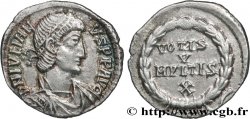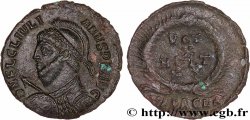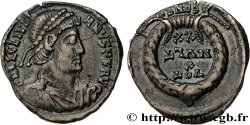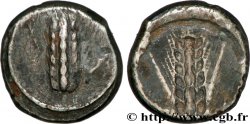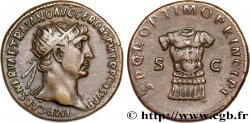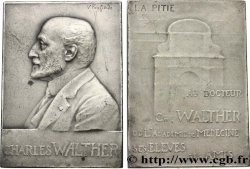brm_289278 - IULIANUS II DER PHILOSOPH Nummus (PBQ, Æ 3)
Nicht verfügbar.
Artikel auf unserem Online-Shop verkauft (2014)
Preis : 1 250.00 €
Artikel auf unserem Online-Shop verkauft (2014)
Preis : 1 250.00 €
Type : Nummus (PBQ, Æ 3)
Datum: c. 361-363
Name der Münzstätte / Stadt : Roma
Metall : Kupfer
Durchmesser : 18 mm
Stempelstellung : 2 h.
Gewicht : 2,45 g.
Seltenheitsgrad : R3
Kommentare zum Erhaltungszustand:
Exemplaire idéalement centré avec une belle et rare représentation au droit. Portraits bien venus à la frappe. Usure régulière au revers. Jolie patine verte
Vorderseite
Titulatur der Vorderseite DEO SAR-APADI.
Beschreibung Vorderseite Bustes accolés à gauche d’Isis et Serapis.
Übersetzung der Vorderseite “Deo Sarapadi”, (Au dieu Sérapis).
Rückseite
Titulatur der Rückseite VOTA P-VBLICA.
Beschreibung Rückseite Isis debout de face, la tête tournée à droite, tenant le sistrum de la main droite et une situle de la main gauche.
Übersetzung der Rückseite “Vota Publica”, (Vœux publics).
Kommentare
Ce type est l’un des plus rares de ce monnayage, iconographiquement riche mais de la plus grande rareté dans les collections. Ce monnayage remplissait-il un rôle religieux, un rôle politique, un rôle de propagande ? Près de soixante-dix ans après la publication du travail d’A. Alföldi, ce monnayage reste toujours une énigme. Avec son poids de 2,45g, ce type semble particulièrement lourd et correspond parfaitement à une série à part, dont plusieurs exemplaires sont connus (cf. http://www.ancients.info/forums/showthread.php?t=2386) qui semblent taillés au 1/120e de livre.
This type is one of the rarest of this coinage, iconographically rich but of the greatest rarity in collections. Did this coinage fulfill a religious role, a political role, a propaganda role? Nearly seventy years after the publication of A. Alföldi's work, this coinage still remains an enigma. With its weight of 2.45g, this type seems particularly heavy and corresponds perfectly to a separate series, of which several examples are known (see http://www.ancients.info/forums/showthread.php?t=2386) which seem to be cut at 1/120th of a pound
This type is one of the rarest of this coinage, iconographically rich but of the greatest rarity in collections. Did this coinage fulfill a religious role, a political role, a propaganda role? Nearly seventy years after the publication of A. Alföldi's work, this coinage still remains an enigma. With its weight of 2.45g, this type seems particularly heavy and corresponds perfectly to a separate series, of which several examples are known (see http://www.ancients.info/forums/showthread.php?t=2386) which seem to be cut at 1/120th of a pound








 Berichten über einen Fehler
Berichten über einen Fehler Die Seite drucken
Die Seite drucken Teilen meiner Auswahl
Teilen meiner Auswahl Stellen Sie eine Frage
Stellen Sie eine Frage Einlieferung/Verkauf
Einlieferung/Verkauf
 Details
Details